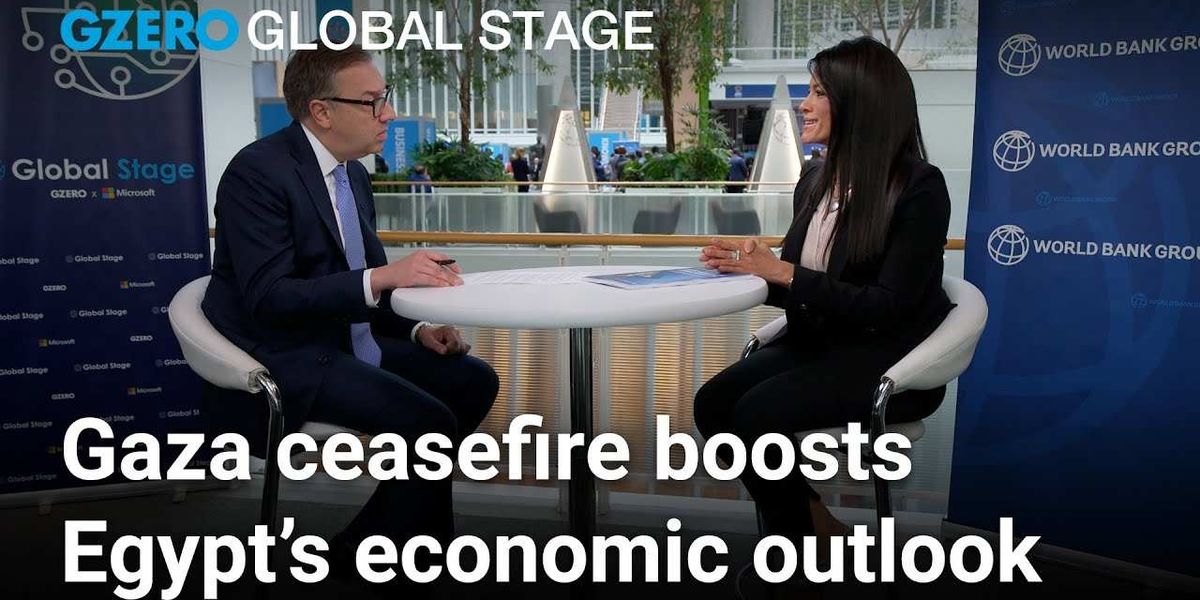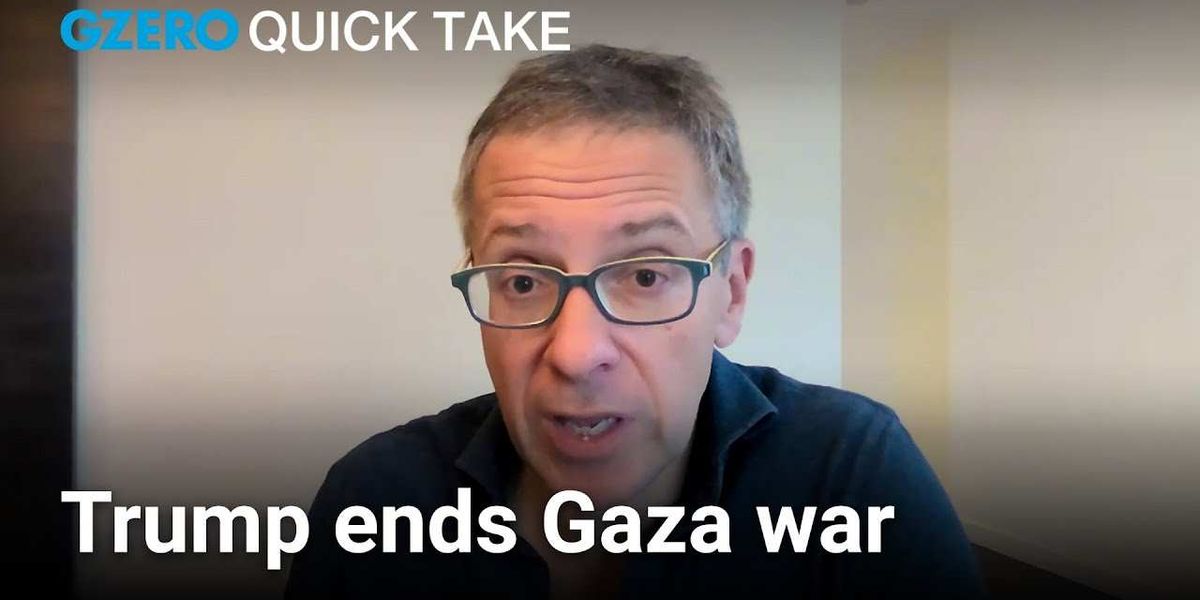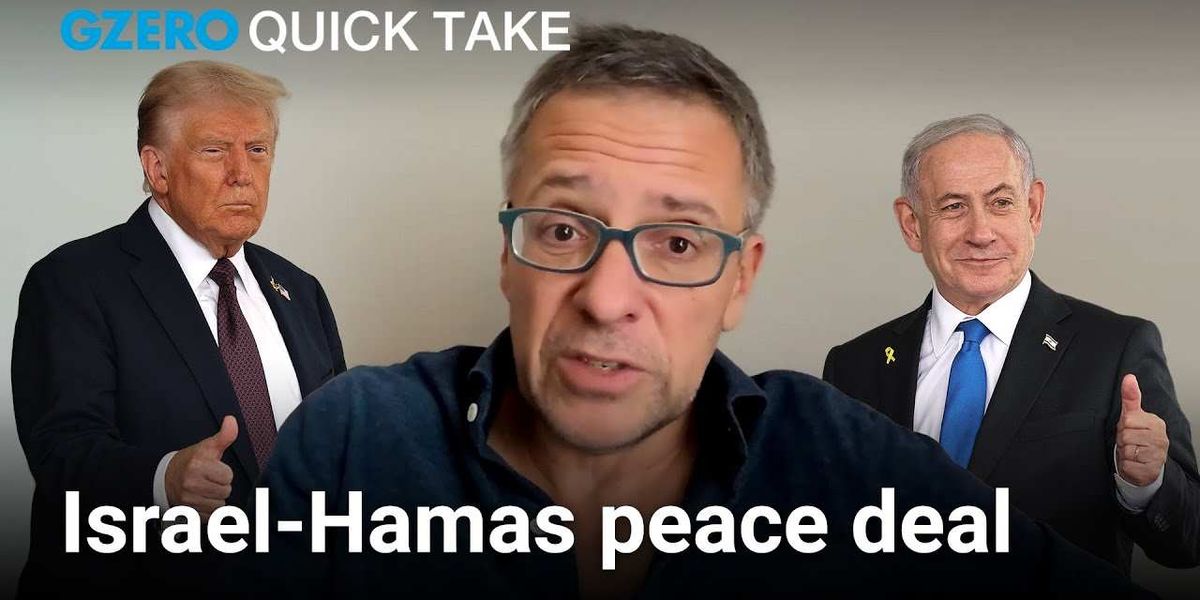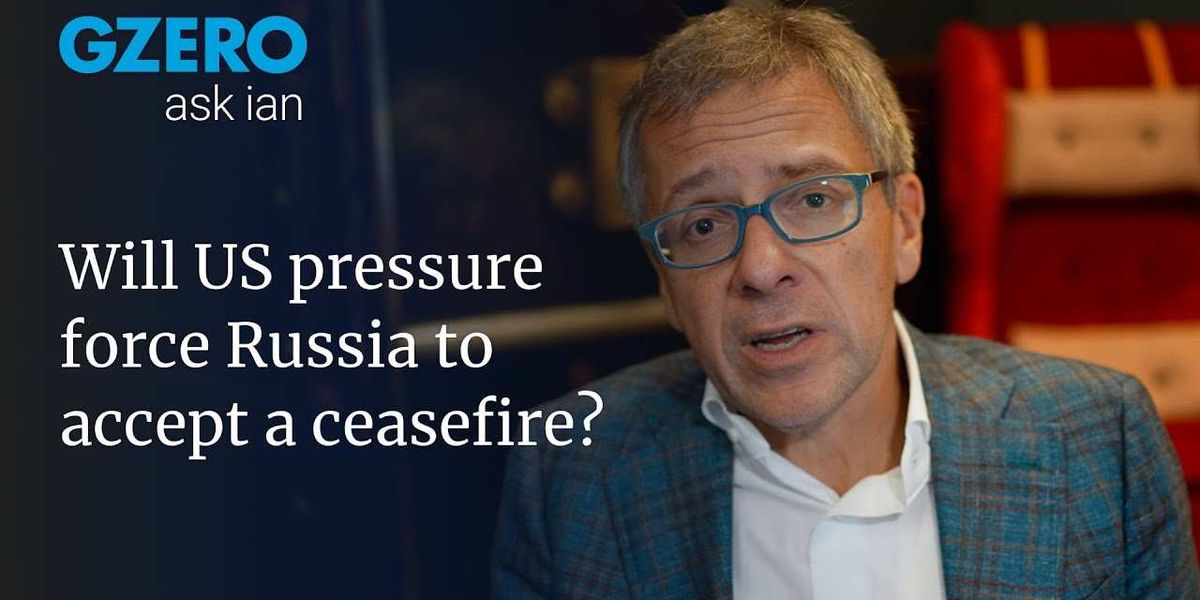Trending Now
We have updated our Privacy Policy and Terms of Use for Eurasia Group and its affiliates, including GZERO Media, to clarify the types of data we collect, how we collect it, how we use data and with whom we share data. By using our website you consent to our Terms and Conditions and Privacy Policy, including the transfer of your personal data to the United States from your country of residence, and our use of cookies described in our Cookie Policy.
{{ subpage.title }}
Servicemen of the 148th Separate Artillery Zhytomyr Brigade of the Armed Forces of Ukraine fire a Caesar self-propelled howitzer towards Russian troops at a position on the front line, amid Russia's attack on Ukraine, near the frontline town of Pokrovsk in Donetsk region, Ukraine November 23, 2025.
What We’re Watching: Russia-Ukraine peace deal, Rough weekend for Brazil, Mass school abductions in Nigeria
Is a Russia-Ukraine peace deal imminent?
After facing backlash that the US’s first 28-point peace deal was too friendly towards Russia, American and Ukrainian negotiators drafted a new 19-point plan on Monday. The talks nearly fell apart before they began, but both sides reported ultimately that the meeting felt “positive.” However, whether this gets Ukraine and Russia any closer to a ceasefire remains to be seen. The new draft apparently bears little resemblance to the original plan – meaning Moscow may not agree. It also does not address the most controversial issues like territorial questions and the future of NATO–Russia–US relations, leaving them for Donald Trump and Volodymyr Zelensky to resolve before Washington’s Thursday deadline.
A rough weekend for Brazil’s Bolsonaro
On Friday, US President Donald Trump gave Brazilian President Luiz Inácio Lula da Silva a boost – and thereby hurt former President Jair Bolsonaro – by cutting tariffs on several Brazilian foodstuffs, including beef, coffee, and fruit (see more here). But things would get worse for Bolsonaro: Police arrested him on Saturday over fears that he would try to escape house arrest to avoid the 27-year sentence he’s serving for plotting a failed coup. The Supreme Court believed the right-wing leader was tampering with his ankle monitor, so granted the arrest. Trump had placed 50% tariffs on Brazil over its treatment of Bolsonaro, but his priority appears to be shifting.
Another spate of mass school abductions rock Nigeria
Several Nigerian states have shut their schools following a spate of mass abductions over the weekend, adding yet another dilemma to the mounting security crisis in Africa’s most-populous country. The most notable abduction took place on Friday in Niger State, where gunmen kidnapped 315 children and 12 teachers – 50 of the children have since escaped. President Bola Tinubu announced afterwards that he would recruit another 30,000 police officers. With the Islamist militant group iSWAP sowing violence in the north, violence burgeoning between farmers and herders in the central Benue state, and these latest abductions, Tinubu’s to-do list is getting long and difficult.
Displaced Palestinians live in tents near destroyed buildings as they cannot return to their houses, amid a ceasefire between Israel and Hamas, in Gaza City, on October 19, 2025.
What We’re Watching: Tense Gaza ceasefire holding again, Trump pressed Zelensky on Donbas during Friday meeting, Japan to have first female PM
Ceasefire returns to Gaza after weekend exchange of fire
The US and the Israeli military said Sunday that the ceasefire is holding again in Gaza, after the two sides exchanged fire over the weekend in what was the biggest test so far of the peace plan signed last week. The flare up appeared to begin when Hamas militants – reportedly acting independent of the group’s leadership – hit Israeli soldiers with gunfire and anti-tank missiles, killing two soldiers. Israeli forces responded with a wave of airstrikes, killing 26 people, per local authorities. Israel said it bombed Hamas targets in the enclave, but one of the strikes hit a former school that was sheltering some displaced persons. The ceasefire remains a tenuous one, as Israel seeks the return of the remains of the last 16 hostages, while Hamas demands more aid. The next 30 days, per one US official, will be “critical.”
Trump presses Zelensky to cede Donbas in heated meeting
US President Donald Trump urged Ukrainian President Volodymyr Zelensky to give up the Donbas region and accept a ceasefire deal on Friday, during a meeting that reportedly devolved into a “shouting match” where Trump echoed the talking points that Russian President Vladimir Putin made on their call the day before. Zelensky hoped the meeting would result in the US supplying Ukraine with long-range Tomahawk missiles, a request Trump denied. US Secretary of State Marco Rubio and Russian Foreign Minister Sergei Lavrov will speak in the coming days to prepare a new Trump-Putin summit in the next few weeks – something Zelensky signaled he would be open to attending if invited.
Japan set to have first female PM
Sanae Takichi, elected leader of the center-right Liberal Democratic Party last week, is set to become Japan’s first female prime minister, after her party penned a coalition deal with the right-wing Japan Innovation Party on Monday. The agreement means Takichi will have just enough support when Parliament votes on her ascension tomorrow. The Japan Innovation Party replaces Komeito as the LDP’s coalition partner following outgoing PM Shigeru Ishiba’s decision to resign, meaning the government will take a more pro-business approach. Takichi won’t be the first female leader of Japan, though: Eight empresses have previously ruled over the island.
Egypt's path to economic stability with Rania Al-Mashat
As a landmark Gaza ceasefire reshapes Middle East stability, what does it mean for Egypt’s growth outlook?
Egypt’s Minister of Planning, Economic Development, and International Cooperation, Rania Al-Mashat tells GZERO’s Tony Maciulis the deal is “a monumental moment” and durable. “There’s no development without stability and peace,” she says, citing urgent Gaza reconstruction.
Despite recent changes, Egypt achieved a 5% economic growth, fueled by strategic reforms and a robust tourism sector. Highlighting progress, Al-Mashat shared Egypt's success in attracting over $17 billion in private sector investment, focusing on key industries like ICT and manufacturing. She notes, “Our economy has been rebounding, recovering very steadily.”
This conversation is presented by GZERO in partnership with Microsoft.. The Global Stage series convenes global leaders for critical discussions on the geopolitical and technological trends shaping our world.
Trump brokers peace: Hostages freed and guns fall silent in Gaza
A landmark moment in the Middle East: All 20 remaining Israeli hostages held by Hamas have been released, and a ceasefire agreement between Israel and Hamas has been signed—brokered by President Trump.
Ian Bremmer calls it “a big win” for the president. “He had leverage, and he used it,” Ian says. “It’s much better to say your president succeeded than failed—and this is a success.”
The deal, backed by Egypt, Turkey, and Gulf states, halts two years of fighting. But as Ian notes, “lasting peace will depend on reconstruction, governance, and whether both sides can hold to their word.”
Trump's role in brokering Israel-Hamas deal
After two years of war in Gaza, a ceasefire and peace deal may finally be within reach, and Ian Bremmer says former President Trump deserves credit for.
“Trump has announced an agreement on a Gaza ceasefire,” Ian explains. “It’s not done yet, but it’s a big deal.” With help from advisors Jared Kushner, Steve Witkoff, and Marco Rubio and quiet backing from Gulf states, Trump has reportedly convinced Hamas to release 48 hostages and Israel to scale back operations.
“If it happens,” Ian says, “it’s a breakthrough that Biden, the Gulf, and Europe couldn’t deliver. And that deserves recognition.”
Members of the Kurdish-led Syrian Democratic Forces (SDF) hold a flag in the divided city of Deir al-Zor, Syria December 7, 2024.
Hard Numbers: Syria reaches pact with Kurdish fighters, Sudanese militia leader guilty of war crimes, emerging markets surge anew, luxury travel booms
¼: The new Syrian government has signed a ceasefire with US-backed Kurdish fighters who control roughly a quarter of Syria’s territory, in a pact that could smooth the re-integration of Kurdish areas into the Syrian state. Recent clashes had upended earlier agreements to absorb Kurdish militias into the new Syrian army.
27: The international criminal court has found a leader of Sudan’s feared janjaweed militia guilty on 27 counts of atrocities committed during the Darfur genocide in the early 2000s. The charges included gang rape of women and children, torture, and summary executions. The court rejected the defendant’s arguments that it had captured the wrong man.
15: Stocks of companies in “emerging markets” – a grouping of the world’s leading middle-income countries – have seen their biggest gains in more than 15 years. The main reason? A weaker US dollar has made it easier for companies in these countries to service dollar-denominated debt. At the same time, many of these economies are keeping interest rates high, attracting more foreign capital, particularly as political uncertainty roils developed markets like the US and Europe.
390 billion: The rich keep getting richer… and then they go on holiday. Global spending on high end luxury travel will surpass $390 billion by 2028, according to McKinsey, up from $240 billion in 2023. Experts say the increasing availability of luxury goods has made them less interesting to the ultra-rich, who now flaunt their 1-percentness by seeking out stratospherically expensive and unique luxury experiences.
Trump shifts on Russia: From carrots to sticks in Ukraine war
For years, US policy toward Russia’s war in Ukraine has swung between extremes. Under Biden, “all stick, no carrot.” Under Trump, “all carrot, no stick.” Ian Bremmer says both approaches failed to change Vladimir Putin’s calculus.
What’s different now? Trump himself admits his personal diplomacy with Putin has failed—a rare concession. Instead, he’s pushing oil pressure: urging Hungary, Turkey, and India to cut Russian crude purchases, and exploring deals with Ukraine on drones and long-range missiles.
“The US is closer today to the Ukrainian and European position than Trump was months ago,” Ian notes. “That’s a shift worth watching.”
Can the UN stop death and destruction in Gaza?
In a sobering conversation at the United Nations HQ, UN Secretary-General António Guterres addresses the mounting humanitarian crisis in Gaza. While declining to weigh in on genocide allegations—“I have no competence to declare or not genocide,” he says—Guterres does not hold back on the reality on the ground.
“The problem is not the name. The problem is the reality… the highest level of death and destruction that I’ve ever seen in my public life.”
Guterres calls for an immediate, permanent ceasefire, the unconditional release of hostages. full humanitarian access, and a renewed push for a two-state solution, which he says is the only viable path to peace “What’s happening today in Gaza is morally, politically, and legally intolerable.”
He warns that Israel's current path, and its stated willingness to live with greater global isolation, risks deepening regional instability: “[Benjamin Netanyahu] has the possibility to solve that problem… by recognizing that another people are in the same land and that other people also needs to have a state and to live.”
GZERO World with Ian Bremmer, the award-winning weekly global affairs series, airs nationwide on US public television stations (check local listings).
New digital episodes of GZERO World are released every Monday on YouTube. Don't miss an episode: subscribe to GZERO's YouTube channel and turn on notifications (🔔). GZERO World with Ian Bremmer airs on US public television weekly - check local listings.




